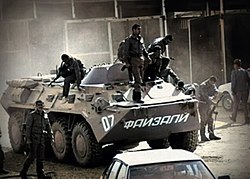Stasso Civil War
| Stasso Civil War | |||||||
|---|---|---|---|---|---|---|---|
 Stasso government soldiers during the Civil War | |||||||
| |||||||
| Belligerents | |||||||
|
|
Secularist socialist factions Supported by | ||||||
| Strength | |||||||
| Estimated around 60,000–70,000 | |||||||
| Casualties and losses | |||||||
| Unknown | Unknown | ||||||
|
30,000–43,000 killed 1.1 million displaced | |||||||
The Stasso Civil War began in May 1992 when regional secular groups from the northern regions of Stasso rose up against the Orthodox-backed government. The rebel groups were led by a combination of secular reformers and communists, who would later organize under the banner of the United Stasso Opposition, and they were backed by the Alliance of Central Euronian States and the Slavic Union. The government was supported by the military, religious factions (mainly the Orthodox Church), and much of the neighboring community.
The main zones of conflict was in the country's major cities of Bohubem, Dniproyi, Myrance, although fighting occurred nationwide. The civil war was at its peak during its first year and continued for five years, devastating the country. An estimated 20,000 to 43,000 people were killed in the conflict, and about 10 to 20 percent of the population of Stasso were internally displaced. On 12 May 1997, Stasso's president Ikovle Nikitovich, United Stasso Opposition (UsO) leader Luka Vladimirovich, and CCA Secretary-General Edward Holly signed the General Agreement on the Establishment of Peace and National Accord in Stasso in Vilhofen, Chaesia, ending the war.